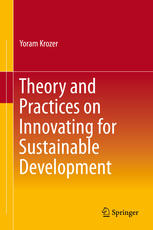

Most ebook files are in PDF format, so you can easily read them using various software such as Foxit Reader or directly on the Google Chrome browser.
Some ebook files are released by publishers in other formats such as .awz, .mobi, .epub, .fb2, etc. You may need to install specific software to read these formats on mobile/PC, such as Calibre.
Please read the tutorial at this link: https://ebookbell.com/faq
We offer FREE conversion to the popular formats you request; however, this may take some time. Therefore, right after payment, please email us, and we will try to provide the service as quickly as possible.
For some exceptional file formats or broken links (if any), please refrain from opening any disputes. Instead, email us first, and we will try to assist within a maximum of 6 hours.
EbookBell Team

4.7
76 reviewsThis book explains how income growth and better environmental qualities go hand in hand, and reviews the drivers and barriers to sustainable innovation on the basis of real-life cases. It discusses why innovation-based income growth reduces environmental impacts and how the huge global markets for sustainable innovation are currently hampered by protectionist policies. Subsequently, diverse sustainable innovators are presented in ascending order of the complexity of interactions between innovators and stakeholders. In this context, innovating consumers who create communities of peers in solar powered mobility are examined in the first case. It also focuses on regional tacit inventors, who spur innovation in tourism mobility thanks to the informal policies but whose efforts are obstructed by the formalities of the European Union. Artists with an interest in both innovations and the environment develop art services that deliver experiences of environmental qualities. Though these experiences have gone unrecognised so far, they are nonetheless socially beneficial. The book also shows how technology suppliers develop four different patterns of sanitation, each with its own pros and cons for the specific community’s needs and conditions. It discusses how project developers also make innovations in office systems, including socially beneficial ones that do away with the need to commute. It includes an analysis of interactions between consumers pursuing ethical consumption and international trailblazers in corporate responsibility and concludes that it is more rewarding to support social entrepreneurs than to attempt to moralise consumers. Further analysis of interactions between sustainable investors and innovators reveals different groups’ opinions about policies and markets, helping to explains their weak influence on policies. Mushrooming local energy initiatives are now evolving into energy service companies, producing shifts on energy markets. Why these innovators emerge and how certain policies are blocking them are explained. The policies of the United States and European Union are compared with regard to the main barriers to and drivers of, the renewable energy business. Though the US invests more money and takes more risks, it is less cost-effective in terms of the number of enterprises and jobs, thanks to the feed-in tariffs in Europe. Lastly, the book also discusses policies that invest in education, skills, knowledge and know-how exchange, but instead abolish perverse?? subventions of vested interests to?? create conditions for sustainable development.